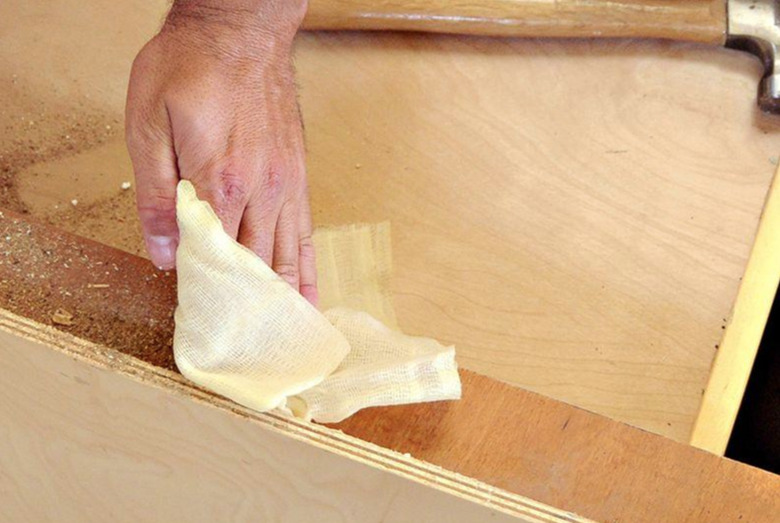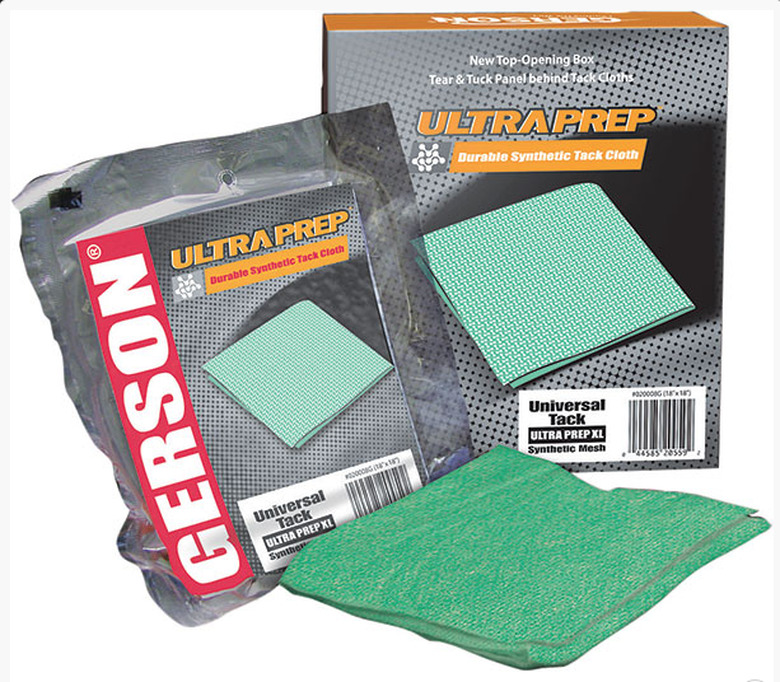What Is A Tack Cloth And How Is It Used?
Tack cloth is a slightly sticky, reusable piece of fabric material used specifically for removing fine particles off surfaces before you apply a finish to them. For example, you must wipe sawdust off a woodworking project before applying varnish if you want to achieve a flawless appearance. Likewise, cleaning dirt, lint, and any other debris off baseboards or window trim before painting them will result in a smoother look. A tack cloth accomplishes these tasks. You should also use one to wipe off surfaces between coats of stain or paint.
Tack cloths are better than a damp rag because water can damage porous surfaces. They're also different (and much more effective) than an old T-shirt used as a dry rag because they're chemically treated so a maximum amount of dust clings to them. The "tack" factor comes from the cloth being coated in a resinous material, usually a petroleum derivative. Many commercial products are free of wax and silicone that might leave residue on surfaces.
Tack cloths are typically made of cotton gauze or cheesecloth in meshes of various tightness, but because this material can shed lint, manufacturers have solved that problem with the introduction of continuous filament synthetic yarns that are non-fibrous.
How to Use
How to Use
Tack cloths are for smaller projects. (You wouldn't wipe an expanse of floor or wall with one.) Using a tack cloth couldn't be simpler:
- Vacuum or wipe off any large debris from the surface you want to clean.
- Put on disposable gloves to avoid getting sticky residue on your hands. If you're using a new tack cloth straight out of the package, completely unfold it. Bunch it up in your hand.
- Gently wipe the surface to be cleaned immediately before applying a coat of finish. Keep a light touch—you want to avoid leaving behind any traces of residue from the adhesive in the tack cloth.
Store the tack cloth in a resealable sandwich bag to keep it from drying out and accumulating grime. Never rinse or wash a tack cloth. When it's saturated with dust and dirt, throw it away; don't burn it.
Tip
Don't use a tack cloth on
- Dirt and large debris. Tack cloths are designed for dust and other small particles. Either vacuum or wash off the dirt first.
- Damp surfaces.
- Glass, ceramic, porcelain. The tack cloth will leave streaks on them.
- Fabric and leather. It won't remove dust from soft materials.
Make Your Own Tack Cloth
Make Your Own Tack Cloth
Commercial tack cloths cost very little, so you probably won't save any money making your own, but it might come in handy.
Things Needed
-
Disposable gloves
-
Laundered lint-free cotton, or new cheesecloth, 18 x 36 inches
-
Disposable bowl
-
Warm water
-
Turpentine
-
Varnish
-
An airtight jar
- Put on disposable gloves. Soak the fabric in the warm water, then wring it out as much as possible. Fold it a number of times to make a small pad.
- Pour just enough turpentine onto the pad to moisten it, then knead it through the fabric.
- Pour a small amount of varnish onto the pad, and knead it completely through the fabric until it's an even shade of pale yellow.
Store the tack pad sealed in the airtight jar; it can spontaneously combust otherwise. If it dries out during use, you can refresh its tackiness by kneading in a few drops of turpentine and varnish.
Warning
Heads up: Tack cloths can leave behind oils that are incompatible with water-based finishes. So if you're going to be applying a water-based finish to your project, look for a commercial tack cloth designed to be compatible with all paints. Or, you can also use a microfiber towel instead of a tack cloth. Remember never to put a washed microfiber towel in the dryer, as it will collect lint—instead, hang it to dry.

